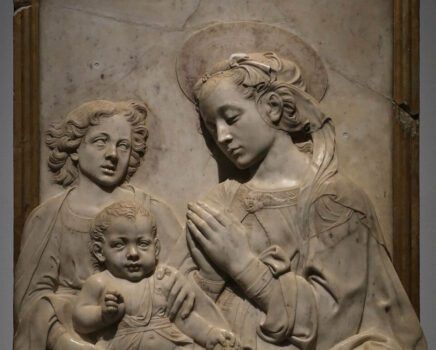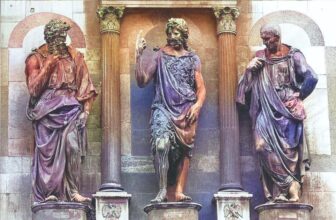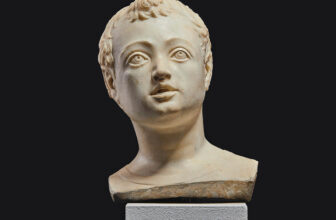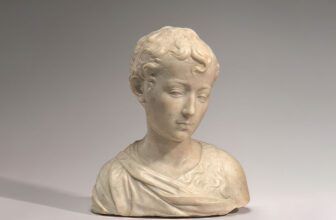What are Simone Ferrucci’s most famous Sculptures
| Invest in Hidden Masterpiece: Rare Antique Oil Paintings For Sale. Limited Originals Available 💰😊 Are you looking for authentic hidden masterpiece? Explore old master antique oil paintings from the Renaissance and Baroque eras. From 16th-century portraits to 18th-century landscapes. Authenticity guaranteed, Old Master antique oil paintings for sale. Shop Now! 🎨 Renaissance And Baroque Art Landscape Antique Paintings Old Master Portrait Paintings |
In the glittering tapestry of Renaissance art, names like Michelangelo, Donatello, and Ghiberti dominate the narrative. Yet hidden among these titans are lesser-known but equally talented artists whose work played a vital role in shaping the aesthetic and spiritual life of 15th-century Italy. One such figure is Simone Ferrucci (c. 1437–1493), a Florentine sculptor whose work exudes the grace, piety, and refined form of the Quattrocento. Though not as widely celebrated today, Ferrucci’s sculptures were highly regarded in his time and contributed to the sacred and artistic architecture of Florence and beyond.
This post takes a deep dive into Simone Ferrucci’s life, his most famous sculptures, his artistic style and techniques, the worth of his surviving works, and where you can see them today.
The Life and Times of Simone Ferrucci
Simone Ferrucci was born around 1437 in Fiesole, a hilltop town just outside Florence. He hailed from an artistic family, his father, Simone di Nanni Ferrucci, was also a sculptor, and his cousin was Andrea Ferrucci, another prominent sculptor of the time. This familial environment of craftsmanship and artistic tradition significantly influenced Simone’s early development.
Ferrucci moved to Florence during his formative years, immersing himself in the thriving artistic scene of the Florentine Renaissance. He was believed to be a pupil or at least heavily influenced by Desiderio da Settignano and Andrea del Verrocchio, two of the greatest sculptors of the period. Ferrucci absorbed their techniques and ideals, especially their delicate rendering of human forms and serene, almost angelic facial expressions, hallmarks of the early Renaissance style.
He joined the Arte dei Maestri di Pietra e Legname (the Guild of Stone and Wood Workers) in Florence in 1463, solidifying his status as a professional sculptor. Throughout his life, Ferrucci focused primarily on religious commissions, creating altarpieces, tabernacles, and devotional statues for churches and private patrons. He passed away in 1493, leaving behind a modest but poignant body of work that reflected the spiritual and aesthetic currents of his time.
What Is Simone Ferrucci Known For?
Simone Ferrucci is best known for his religious sculptures, particularly his Madonnas, Christ figures, and angelic representations, that adorn various churches and altarpieces across Tuscany. He specialized in marble and wood sculptures, with a refined technique that emphasized graceful drapery, gentle expressions, and intimate religious emotion.
His work is distinguished by:
-
Delicate Facial Features: Ferrucci’s figures, especially the Madonna and Child, are noted for their serene and almost ethereal facial expressions.
-
Mastery of Proportion: His ability to convey grace through proportion and pose contributed to the calm and devotional quality of his works.
-
Elegant Drapery: His treatment of fabric and folds is fluid and natural, enhancing the spiritual feel of the sculptures.
-
Devotional Intimacy: Ferrucci’s sculptures were often designed for intimate worship settings, such as chapels and private altars.
Simone Ferrucci’s Most Famous Sculptures
Though his works are not as widely circulated or celebrated today, several of Ferrucci’s pieces have been identified and preserved. His most significant and famous sculptures include:
1. Madonna and Child (c. 1470–1480)
-
Material: Marble
-
Location: Bargello Museum, Florence
Perhaps Ferrucci’s most widely studied work, this sculpture epitomizes his style. The Madonna’s calm gaze and the tender posture of the Child convey an almost palpable warmth. The composition is compact, symmetrical, and devotional, inviting contemplation rather than grandeur.
2. Tabernacle with the Madonna and Child, Angels, and Saints (c. 1480)
-
Material: Painted and gilded wood
-
Location: Museo dell’Opera del Duomo, Florence
This intricate wooden altarpiece features multiple figures arranged in a classic Renaissance architectural framework. The use of polychrome (painted color) and gilding adds vibrancy, a hallmark of late 15th-century ecclesiastical decoration. The angels are especially noteworthy for their youthful innocence and lively expressions.
3. Relief of the Adoration of the Magi
-
Material: Marble relief
-
Location: Private collection, Florence
Though in private hands today, this relief shows Ferrucci’s talent in narrative sculpture. The dynamic procession of the Magi is balanced by the still, contemplative figure of the Madonna. It showcases Ferrucci’s skill in organizing complex compositions within confined frames.
4. Christ on the Cross (Crucifix)
-
Material: Wood (polychromed)
-
Location: Church of Santa Maria a Peretola, Florence
This expressive crucifix, attributed to Ferrucci, demonstrates his skill in rendering the human body in states of suffering and spiritual transcendence. The pathos in Christ’s face and the anatomical precision reflect the influence of Donatello and Verrocchio.
How Did Simone Ferrucci Make His Sculptures?
Ferrucci was a meticulous craftsman who employed traditional Renaissance sculptural techniques, drawing from both classical antiquity and Gothic precedents. Here’s an overview of his process:
1. Material Selection
Ferrucci worked primarily in marble and wood, choosing his material based on the commission and its location. Marble was favored for high-end or public works, while wood was often used in polychrome tabernacles and altarpieces.
2. Sketches and Models
Like other Renaissance sculptors, Ferrucci would begin with preliminary sketches, sometimes on parchment, and then create clay or wax models. These maquettes served as a guide for the final work and were often shown to patrons for approval.
3. Carving and Sculpting
-
For marble: Ferrucci used chisels, rasps, and drills to achieve his characteristic delicate detail. His background with Verrocchio’s school likely introduced him to newer tools and methods to enhance surface finish and accuracy.
-
For wood: He used gouges and knives to sculpt figures and architectural features, later applying gesso, gold leaf, and tempera paint for lifelike finish.
4. Finishing Touches
Marble works were polished with abrasives like pumice or even straw to give them a soft sheen. For wooden sculptures, coloring and gilding were done by skilled painters, sometimes in collaboration with Ferrucci.
Ferrucci’s technique balanced technical precision with emotional subtlety, giving his sculptures a timeless quality.
How Much Are Simone Ferrucci’s Sculptures Worth?
Determining the value of Renaissance sculptures can be challenging due to their rarity and dependence on provenance, condition, and market demand. Simone Ferrucci’s works, though not commanding prices on the level of Michelangelo or Donatello, are nonetheless highly valuable due to their historical significance and artistic quality.
Estimated Values:
-
Marble Madonna and Child: Between $200,000 and $500,000, depending on size and provenance.
-
Wooden Tabernacles or Altarpieces: Upwards of $100,000 to $300,000, particularly if gilded and well-preserved.
-
Reliefs and smaller devotional sculptures: Typically in the $50,000–$150,000 range.
Auctions featuring Renaissance religious art, such as those by Sotheby’s or Christie’s, occasionally list sculptures attributed to Ferrucci or his workshop. In 2012, a marble Madonna by an artist from the Ferrucci circle sold for over $350,000, suggesting the high value associated with the name.
Where Are Simone Ferrucci’s Sculptures Located Today?
Although many of Ferrucci’s works were created for specific churches, over the centuries they have been moved to museums, private collections, and ecclesiastical archives. Here are some of the primary locations where his works can be found:
1. Bargello Museum (Museo Nazionale del Bargello), Florence
-
Houses the marble Madonna and Child attributed to Ferrucci.
-
This museum contains one of the world’s finest collections of Renaissance sculpture.
2. Museo dell’Opera del Duomo, Florence
-
Features a wooden tabernacle with Ferrucci’s figures.
-
Located next to Florence Cathedral, this museum preserves many ecclesiastical works from the Renaissance.
3. Church of Santa Maria a Peretola, Florence
-
Displays Ferrucci’s wooden Christ on the Cross.
-
A beautiful and intimate church setting where the sculpture retains its devotional context.
4. Church of Santa Croce, Florence (possible attribution)
-
Some scholars have attributed side altarpiece figures to Ferrucci or his workshop.
5. Private Collections
-
Several of Ferrucci’s smaller sculptures and reliefs reside in private European and American collections.
-
These works are occasionally loaned to exhibitions, though many remain out of public view.
Why Ferrucci Matters Today
Simone Ferrucci may not be as universally recognized as his more famous contemporaries, but his work remains a precious window into the spiritual and artistic values of the early Renaissance. His sculptures embody the gentleness, introspection, and reverence that characterized the devotional art of the period. They also serve as reminders of the collaborative nature of Renaissance workshops, where even lesser-known artists contributed immensely to the cultural fabric of Italy.
In a modern context, Ferrucci’s work is being re-evaluated by art historians and curators seeking to broaden the canon of Renaissance masters. His sculptures, once seen as peripheral, are now appreciated for their quiet beauty and technical refinement.
Simone Ferrucci, though not a household name, deserves recognition as a master of early Renaissance sculpture. His work stands out for its emotional depth, technical finesse, and spiritual resonance. From his serene Madonnas to his poignant Crucifixion scenes, Ferrucci crafted sculptures that were not only art but also vessels of faith and devotion.
For those fortunate enough to visit Florence or gain access to rare private collections, Ferrucci’s sculptures offer a compelling, meditative experience, one that transports the viewer back to a time when art was both an aesthetic pursuit and a path to the divine.
If you’re exploring Renaissance art or planning a visit to Florence, be sure to include Simone Ferrucci on your list. His work may not be in the spotlight, but it shines in its own quiet, eternal way.
Sources and Further Reading
-
Pope-Hennessy, J. “Italian Renaissance Sculpture”
-
Bargello Museum Official Website
-
Museo dell’Opera del Duomo Collections
-
Sotheby’s Auction Catalogues
-
Grove Art Online (Oxford Art)
Image/wikimedia.org




